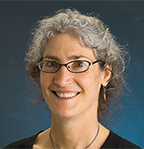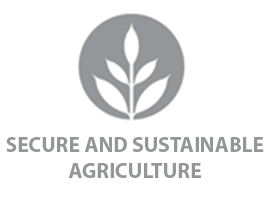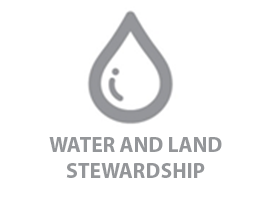Agroforestry for Food Project
Research Menu
 Current
Current
Funded
iSEE Work
 Current
Current
Funded
iSEE Work
Current
Funded
iSEE Work
Current
Funded
iSEE Work
Current
Funded
iSEE Work
In former Lead Investigator Sarah Taylor Lovell’s words:
“My Agroforestry for Food team is studying an alternative option for agriculture in the Midwest, initially targeting areas that are not best suited for row crops. We are comparing a variety of systems — mixtures of trees, shrubs, and forage or hay — that yield multiple food (and fuel) products including fruits and nuts.
“We call them ‘Multifunctional Woody Polycultures’ because of the potential benefits of a more complex mix of permanent species. In addition to providing harvestable products in abundance, these alternative systems could offer environmental benefits such as permanent wildlife habitat, efficient use of nutrients, and storage of carbon — all of which we will measure.
“We recognize that these systems must be profitable for the farmer, so we are accounting for all costs and income streams to compare with the conventional corn-soybean rotation. We will also explore the potential for alternative agriculture to contribute to healthier rural communities by improving the agricultural landscape and providing job opportunities for residents.”
Project News
- Summer 2020 Progress Update
- Summer 2019 Progress Update
- Summer 2018 Progress Update
- Gift Endows Summer Undergraduate Interns
- USDA invests in A4F research
- Team Publishes on Benefits of Alley Cropping
- Summer 2017 Progress Update
- New paper in Agroforestry Systems journal
- Summer 2016 Progress Update
- First Harvest!
- New Planting at Research Site

From new PI Alexandra Harmon-Threatt and her group:
- Among the findings is a comparison in the insect abundance at an agroforestry site vs. a traditional corn/soy row plot (pictured).
- Samples have been collected from the energy farm but not processed yet; but in the older Woody Perennial Polyculture plot, more than 12,000 specimens were collected.
From PI Wendy Yang’s group:
- Work is divided between research at the A4F site and at three working farms, funded by a USDA grant (Yang, Eddy, and Guest, 2017).
- On the Energy Farm, the team completed its last year of work to measure soil nitrogen leaching from MWP plots (104 total measurements). Researchers continued to monitor soil moisture and temperature in order to be able to model soil water cycling.

Measurements at the Agroforestry for Food plots continue.
- For the USDA work, the team continued to measure ecosystem services production from three woody polyculture fields, including comparisons between corn/soybean rotations and woody polyculture, and between different fertilizer treatments (conventional, organic, and no fertilizer) in woody polyculture. Researchers also completed measurements of annual nutrient leaching, soil greenhouse gas emissions, and yield.
- And an undergraduate-led effort began to measure soil arthropods’ abundance, diversity, and detritivore activity, as well as measuring soil microbial biomass and soil extracellular enzymes.
From PI Bruce Branham and his team:
- “We’ve discovered that hazelnuts and chestnuts are marginally adapted to central Illinois, and both species are being replaced,” Branham said. “We have located another variety of hazelnuts that have shown the ability to thrive under Midwest conditions, and those will be replanted in spring 2021.”

Black currant harvest.
- In Spring 2020, the team pulled out the few surviving chestnuts and are replacing them with pecans established from seed. Branham said pecans are at their northern limit of adaptation, but the team planted pecans in its diversified Treatment No. 7, and they are thriving. With climate change, growing conditions for pecans should only get better over time.
- “We also have realized that Agroforestry for Food is a great concept with many environmental benefits,” he said. “However, establishment time is a major drawback from a research perspective, but a positive once the trees mature and begin producing food since these tree crops have very long, productive lifespans.”
- The team also chose to change its planting design. “Our initial concept was to have rows interplanted with trees and productive shrubs, black currants, separated by 30-foot buffers of pasture,” Branham said. “The pasture would then be harvested and sold for hay. Having multiple species in the same row makes sense biologically and experimentally, but fails the practically test. Harvesting needs to be mechanized to be efficient, and having multiple species in the same row precludes mechanical harvesting.” With the replant to replace hazelnuts and chestnuts, the A4F team will also place the tree crops in individual rows staggered between the product shrub crop, black currants.
Some exciting updates from outgoing PI Sarah Taylor Lovell and Co-PI Wendy Yang:
New External Grants to Bolster Project/Use the A4F Field
 A4F Co-PI Nick Paulson (right), Assistant Professor of Natural Resources and Environmental Sciences Kaiyu Guan (lead), Clinical Assistant Professor of Agricultural and Consumer Economics (ACE) Jonathan Coppess, and ACE Professor Gary Schnitkey received $1.2 million from the U.S. Department of Agriculture’s National Institute of Food and Agriculture (NIFA) to lead a study through 2021 titled “An Integrated Approach to Assessing Cover Crops as an Adaptation to Improve Resilience of U.S. Midwest Ecosystems.”
A4F Co-PI Nick Paulson (right), Assistant Professor of Natural Resources and Environmental Sciences Kaiyu Guan (lead), Clinical Assistant Professor of Agricultural and Consumer Economics (ACE) Jonathan Coppess, and ACE Professor Gary Schnitkey received $1.2 million from the U.S. Department of Agriculture’s National Institute of Food and Agriculture (NIFA) to lead a study through 2021 titled “An Integrated Approach to Assessing Cover Crops as an Adaptation to Improve Resilience of U.S. Midwest Ecosystems.”- Paulson, Guan (lead), Coppess and Schnitkey also received $373,906 from the Illinois Nutrient Research & Education Council for a study through 2020 titled “Assessing Suitability and Benefits of Cover Crops in Illinois.”
- The A4F site will serve as a field site for testing Ag-bots and if they will be able to replace labor needs in a $899,998 study through 2022 titled “Multipurpos Dexterous Soft and Continuum Arms for Compact Ag-bots.” Funded by the USDA NIFA and the National Science Foundation’s National Robotics Initiative (NRI), A4F researchers will work with Assistant Professor of Agricultural and Biological Engineering Girish Chowdhary (lead), Assistant Professor of Industrial and Enterprise Systems Engineering Girish Krishnan, and Assistant Professor of Mechanical Science and Engineering Mattia Gazzola. Read more about the project >>>
- Co-PI Bruce Branham and Illinois Energy Farm Operations Director Tim Mies received about $50,000 from the Student Sustainability Committee to install irrigation for the A4F site.

The A4F site features a filled-in hedge where researchers applied “Treatment 7,” native aronia and elderberry bushes.
Research Progress
- Maintenance of the Multifunctional Woody Polyculture (MWP) field trial has become more routine, and interest/curiosity from individuals within and outside of the University has been growing. Despite success in managing the trial, A4F researchers have experienced challenges with certain species/cultivars that were sensitive to the extreme wet and cold winters. Conversely, plots containing a diversity of native fruiting plants have continued to thrive, creating a full hedge between trees. This information is valuable for potential adopters, so they might find greater success in establishing these systems. The barrier of labor for harvesting is being addressed through the development of an efficient, cost-effective mechanical berry harvester that could be easily replicated by smaller farms and more complex systems (see newly funded Ag-bot project above).
- Yang and her team have completed the second year of a USDA-funded study testing the hypothesis that fertilization could improve the life cycle environmental implications of transitioning from traditional corn and soybean rotations to MWP by accelerating time to productivity and increasing yields while inducing minimal increases in soil nitrous oxide emissions as well as nitrogen and phosphorus leaching. Preliminary results show that soil N2O emissions are not affected by fertilization of woody polyculture and that chestnut yields decreased likely due to a shift to vegetative growth in response to the first year of fertilization.
- The USDA Agriculture and Food Research Initiative (AFRI) project by Lovell and others was initiated in spring 2019 to gather baseline data for the comparison of Conservation Reserve Program (CRP) with MWP treatments.

Co-PI Wendy Yang’s research group began trace gas flux measurements on the A4F farm site in May 2017.
Principal Investigator Sarah Taylor Lovell reports the following accomplishments during Year 4 of the Multifunctional Woody Polyculture (MWP) trial:
- Maintenance of the MWP Field Trial continues to require substantial effort and labor to control weeds, manage insect pests, fertilize individual trees and shrubs, and harvest hay, but we hope the labor commitment will decrease in coming years as the trees and shrubs grow larger. Already, though, the site serves as a popular location for field tours with various groups.
- Research and outreach suggest that the greatest opportunities for increasing adoption of Agroforestry for Food in the near term is through conservation programs that target sensitive lands. In particular, the Windbreak Program in the Conservation Reserve Program (CRP) is mostly compatible with the design of our systems, except for the restrictions on harvesting during the period that the land is in the program. Toward that end, Lovell et al. received a $460,000 U.S. Department of Agriculture’s National Institute of Food and Agriculture (NIFA) grant to compare ecosystem services for CRP versus MWP over a four-year period.
- Co-PI Wendy Yang et al. initiated the USDA-funded study testing the hypothesis that fertilization could improve the life cycle environmental implications of transitioning from corn-soybean rotations to woody polycultures by accelerating time to productivity and increasing yields while inducing minimal increases in soil nitrous oxide emissions as well as nitrogen and phosphorus leaching.
- Co-PI Jeremy Guest’s group developed a model for testing life cycle impacts of a variety of agroforestry scenarios based on National Agricultural Statistics Survey data. That team is analyzing tradeoffs between yields and environmental impacts in farmer decision-making.
- Co-PI Michelle Wander’s group is continuing to work on soil analyses, using a visiting scholar to assist. Graduate student Dane Hunter is studying the influences of community composition and management on resource capture within alley or companion cropped systems.
- Partnerships have been developed with the Savanna Institute to enhance PerennialMap.org as an effort to strengthen and expand an integrated community of WP researchers and farmers in the Midwest.


The Agroforestry for Food team was able to add support for Undergraduate Student Interns during Summer 2018 thanks to a $5,000 gift by Janelle Joseph.
This donation assisted Interns Dylan Raye-Leonard, near right, and Anna Krehbiel, far right.
“The gift was super-helpful for our project this summer, when we needed it most on the farm site,” PI Sarah Taylor Lovell said.

Sarah Taylor Lovell, PI on iSEE’s Agroforestry for Food project
In March 2018, the U.S. Department of Agriculture’s National Institute of Food and Agriculture announced a grant for $460,000 to support research led by University of Illinois scientists Sarah Taylor Lovell, Andrew Margenot, and Alexandra Harmon-Threatt.
Lovell, an Agroecologist in the Department of Crop Sciences at U of I, has been investigating the benefits of multifunctional woody polyculture — a mix of perennial trees and shrubs in the same planted area — for years.
In 2014, iSEE seed-funded the planting of her 30-acre Agroforestry for Food test plot. Polycultures have the potential not only to create habitat, regulate nutrient cycles, and hold soil and carbon, but also to provide harvestable and profitable edible products.
“You’re getting all these benefits, plus the added yield component,” Lovell said. “In this project, we’re asking whether there’s a downside ecologically to choosing this productive type of system instead of traditional species in a Conservation Reserve Program.”
Read the full College of ACES announcement >>>
This grant follows a $495,000 USDA NIFA grant awarded to A4F Co-PI Wendy Yang and others in 2016.
 Members of the Agroforestry for Food team recently published an opinion paper in Global Change Biology about the transformative potential mixed-species alley cropping has for agricultural landscapes like that of Illinois and most of the U.S. Midwest.
Members of the Agroforestry for Food team recently published an opinion paper in Global Change Biology about the transformative potential mixed-species alley cropping has for agricultural landscapes like that of Illinois and most of the U.S. Midwest.
Alley cropping is an agroforestry practice in which trees are planted alongside or in between rows of grain crops in a main production field. In most modern applications, it takes the form of a single tree species comingled with a single grain species. While this arrangement offers many benefits — habitat creation, carbon sequestration, and diversification of farm products — the University of Illinois authors argue that greater benefit could be realized by increasing the number of tree species included and leveraging them for food and fodder production.
For example, stands of trees with multiple species have been shown to remove more carbon dioxide from the atmosphere and store it in soil than stands with only one kind of tree. This could be a powerful climate mitigation strategy.
More and more diverse trees in fields can help adapt agriculture to global change by protecting crops from wind stress, stabilizing air and soil temperatures, increasing soil water infiltration and storage, and reducing evaporation of soil moisture.
To bring these ideas from paper to practice, the team suggests four key considerations that could enhance scalability and speed adoption of multi-species alley cropping:
- Start on marginal lands;
- Determine core tree crops that produce the same carbohydrates, proteins and oils, as corn and soy do now;
- Iteratively develop and employ practical polyculture designs; and
- Find woody species that biologically complement one another.
“Currently, the primary barriers to adoption of AC are the high establishment cost, insufficient tree crop breeding, and relatively high management complexity,” the authors wrote. “These barriers, however, are surmountable with investment in research and updates to agricultural policy.”
A4F team members Kevin Wolz, Sarah Lovell, Bruce Branham, William Eddy, Ron Revord, Michelle Wander, and Wendy Yang were co-authors along with iSEE Director Evan H. DeLucia and Savanna Institute Director Keefe Keeley.
Principal Investigator Sarah Taylor Lovell reports the following accomplishments during Year 3 of the Multifunctional Woody Polyculture (MWP) trial:
 Field establishment was completed, maintenance continues, and harvest begins:
Field establishment was completed, maintenance continues, and harvest begins:
- Improved varieties of chestnuts were grafted onto the seedling rootstock, and grafted apples were planted in designated treatments;
- A weed management program has been established and implemented to ensure success of the woody plants in the early years; and
- Harvest of hay from the alleyway has continued throughout the growing season —and this past summer, Aronia berries (pictured, right) were the first fruit harvested.
- MWP assessment of water quality and quantity continues:
- Analysis includes resin lysimeter samples deployed in the growing season versus non-growing season, and soil moisture tubes in rows and alleys in all plots;
- In selected plots, analysis was expanded to quasi-continuous soil moisture data along the soil profile to 1 meter deep, and wells were added to monitor water table depth; and
- Datasets together with precipitation data from the met station on the eddy flux tower will be used to estimate water flux in each of the treatments.
- Performance trials for individual crop species provide results:
- A replicated study of black currants grown under varying levels of shade (20%, 30%, 50%, and 70%) demonstrates that in the first year of shade, yield is not negatively impacted at levels up to 50%;
- Hazelnuts accessions have been procured and asexually propagated for transition to field-establishment in replicated performance trials;
- An extensive study of the inheritance of eastern filbert blight (EFB) resistance from the endemic Americana hazelnut is being conducted with collaborators at Rutgers University, and a confocal microscopy technique has been developed to gain insight into the molecular mechanisms that underpin EFB-resistance; and
- Trials on alley crop alternatives have been established to study light interactions.
- On-farm research at Red Fern Farm in Wapello, Iowa, shows greater carbon sequestration in polycultures compared to the monocultures and adjacent corn-soy fields — but adjacent forest plots have the highest soil carbon storage; a manuscript presenting the results to a peer-reviewed journal is expected by the end of 2017.
- On-farm research has been expanded to study fertilization effects at three working woody polyculture farms for a U.S. Department of Agriculture project to investigate the tradeoff between yield versus nutrient leaching and soil greenhouse gas emissions.
- A preliminary Life Cycle Assessment model is complete and scenario development has begun to expand the scope of MWP. Scenarios have been identified — focusing on options for the alleyway area as alternatives to hay production, including livestock grazing, organic grain production, additional berry production, and others — for integration of other profitable activities.
In March 2017, the Lovell research team published a paper in the international journal “Agroforestry Systems” encouraging peers in the agroforestry research space to take up live-scale research on multifunctional woody polyculture (MWP): an agricultural system of fruit- and nut-bearing tree species cultivated for profit, ecosystem services, and human health benefits.
While the overall benefits of such systems are well documented, not enough detail is known about how MWP achieves them — from plant-to-plant interaction to water demand. A4F Principal Investigator Sarah Taylor Lovell and her co-authors argue for a network of institution-controlled studies and field trials that could unite “the innovation of growers and the resources of agricultural experiment stations” at land grant universities.”
Continue to the article to read descriptions of three experiments — including the iSEE team’s own 20-acre plot in Urbana-Champaign — used as case studies, and hear the team’s thoughts on the challenges of establishing, maintaining, and funding long-term research trials like these.
PI Sarah Taylor Lovell reports:
- Updates on the Multifunctional Woody Polyculture (MWP) long-term field trial, established in May 2015 at the Energy Farm on a 30-acre site with seven treatments replicated four times …
- Maintenance has been a primary focus over the past year: weed control, wildlife damage, etc.
- An eddy covariance tower was set up to measure carbon and water flux.
- A first cutting of the hay grown in the alleyways between crops was harvested in May 2016 (see next tab).
- Performance trials for individual crop species are underway …
- New hybrids of hazelnuts are being studied for resistance to Eastern Filbert Blight.
- Black currants are being tested for tolerance to shade, to simulate conditions of growing in the understory, beneath chestnuts and hazelnuts.
- Light interception has been modeled for component species at system maturity.
- A Life Cycle Assessment (LCA) has focused on the unproductive years (prior to harvesting) …
- The nursery phase of chestnut trees was completed based on inventory data from a large Midwest nursery, and data for establishment was collected from MWP trial.
 MAY 2016 — The iSEE project team collected its first dividends on its multi-species agricultural experiment. Grass forage was harvested from the alleys between rows of young trees and shrubs on 25 acres of the Agroforestry for Food research plot. Mowing, tedding (fluffing to help it dry), raking and baling took nearly 21 hours over a few days. The fresh bales of hay will be given to the university’s Department of Animal Sciences to feed farm livestock.
MAY 2016 — The iSEE project team collected its first dividends on its multi-species agricultural experiment. Grass forage was harvested from the alleys between rows of young trees and shrubs on 25 acres of the Agroforestry for Food research plot. Mowing, tedding (fluffing to help it dry), raking and baling took nearly 21 hours over a few days. The fresh bales of hay will be given to the university’s Department of Animal Sciences to feed farm livestock.
Annual forage crops grown around and between adolescent fruit and nut trees are an important part of a multi-species agricultural model because they can provide some income on the farm before the slowly maturing perennial shrubs and trees are old enough to produce high-value crops.
MAY 2015 — Sarah Taylor Lovell’s team has begun planting trees and shrubs on a 20-plus-acre plot near the University of Illinois Energy Farm. In the first full week of May, more than 12,000 trees and shrubs were planted, with hazelnuts still to go into the ground in late summer. Each acre plot will feature a different combination (or treatment) of trees and shrubs, in addition to forage and legumes.

Seven different mixtures of plants and placements were planted in May at the research site. Click to view the master map. (Graphic by Paul Littleton.)
On one plot, graduate students Kevin Wolz (above left) and Dane Nelson were planting rows (above center) that contained a Chinese chestnut tree, five currant shrubs, an apple tree, five currants, chestnut, five currants, apple, etc.
Another treatment (above right) included pecan trees and elderberries.
“We envision acreage like this — in which we will actually be storing carbon — as an alternative to traditional corn and soybean farming,” Co-Investigator Bruce Branham said. “With this type of plants, we could start actually reversing the amount of carbon that goes into the atmosphere.
“This project is another step toward mitigating carbon, and if the world starts getting serious about it, we want to move toward being ready to do something like this on a large scale.”
The project will examine how well these different treatments work: Which combinations of plants do better (produce more together) or worse (compete with each other for nutrients) in producing food, feedstock and fuels, Branham said.
“It might take us some time to get the best combinations and breeds of plants,” he said. “After all, it has taken decades to refine corn breeding to achieve maximum production.”
The Team
Principal Investigators and co-PIs
- PI Wendy Yang, Professor of Plant Biology (front right). Her departmental page. Her lab page.
 PI Bruce Branham, Professor of Crop Sciences (right). His departmental page.
PI Bruce Branham, Professor of Crop Sciences (right). His departmental page. PI Alexandra Harmon-Threatt, Assistant Professor of Entomology (right). Her departmental page. Her lab page.
PI Alexandra Harmon-Threatt, Assistant Professor of Entomology (right). Her departmental page. Her lab page.- Co-PI Nick Paulson, Associate Professor of Agricultural and Consumer Economics (back second from right). His departmental page. His Farmdoc page.
 Co-PI Michelle Wander, Professor of Natural Resources and Environmental Sciences (right). Her departmental page. Her lab page.
Co-PI Michelle Wander, Professor of Natural Resources and Environmental Sciences (right). Her departmental page. Her lab page.- Co-PI Jeremy Guest, Associate Professor of Civil and Environmental Engineering (back far right). His departmental page. His lab page.
Operating team: Staff, Postdocs, and Students
- Ian Goller, M.S. Candidate in Environmental Engineering (not pictured). Read more about Ian and his work >>>
- Osenkyerewa Bannerman-Blankson, Undergraduate in Molecular and Cellular Biology: Work Study/Hourly (not pictured).
- Taylor Bozman, Undergraduate in Integrative Biology: Work Study/Hourly (not pictured).
- Sylvia Gewont, Undergraduate in Agricultural and Consumer Economics: Work Study/Hourly (not pictured).
- Audrey Gomez, Undergraduate in Bioengineering and Pre-Medicine: Work Study/Hourly (not pictured).
- Sharell Hicks, Undergraduate in Molecular and Cellular Biology: Work Study/Hourly (not pictured).
- Mary Marsh, Undergraduate in Anthropology: Dixon Springs WPP/Agroforestry/Alley Cropping Intern (not pictured).
- Mary Jane Oviatt, Undergraduate in Food Science and Human Nutrition: Site Outreach and Data Manager for SSC Project (not pictured).
- Kathleen Ross, Undergraduate in Molecular and Cellular Biology: Work Study/Hourly (not pictured).
- Brianna Sarley, Undergraduate in Molecular and Cellular Biology: Work Study/Hourly (not pictured).
- Emina Sipic, Undergraduate in Biology: Work Study/Hourly (not pictured).
Former team members
- Sarah Taylor Lovell (former Principal Investigator), Associate Professor of Crop Sciences (front left), now a Professor at the University of Missouri at Columbia
- William Eddy, Postdoctoral Researcher in Plant Biology (not pictured). Read more about William and his work >>>
- Karl Roeder, Postdoctoral Researcher in Entomology (not pictured).
- Michael Douglass, Research Specialist in Crop Sciences (not pictured).
- Tito Lavaire, Academic Hourly Researcher and Technician in Natural Resources and Environmental Sciences (not pictured).
- Sophie Fruchter, iSEE Field Technician for U.S. Department of Agriculture study (not pictured).
- Jessica Mulcrone, iSEE Field Technician for U.S. Department of Agriculture study (not pictured)
- Zoe Trujillo, AAP Summer Research Fellow in Entomology (not pictured).
- Diana Kapanzhi, Ph.D. Candidate in Environmental Engineering (not pictured). Read more about Diana and her work >>>
- Eric Wolske, Ph.D. Candidate in Crop Sciences (not pictured). Read more about Eric and his work >>>
- Kevin Wolz, Ph.D. Candidate in the Program in Ecology, Evolution, and Conservation Biology (back second from left). Read more about Kevin and his work >>>
- Dane Hunter, Ph.D. Candidate in Natural Resources and Environmental Sciences (not pictured).
- Joseph McAsey, M.S. Candidate in Crop Sciences (not pictured).
- Chloe Mattia, M.S. Candidate in Crop Sciences (not pictured)
- Ronald Revord, Ph.D. Candidate in Crop Sciences (back far left). Read more about Ron and his work >>>
- Erik Stanek, M.S. Candidate in Crop Sciences (not pictured). Read more about Erik and his work >>>
- Matthew Wilson, M.S. Candidate in Crop Sciences (not pictured).
- Sameer Andani, Undergraduate in Cellular and Molecular Biology (not pictured).
- Matthew Anderson, Undergraduate in Natural Resources and Environmental Sciences: Hourly (not pictured).
- Harley Carlson, Undergraduate in Agricultural Leadership and Science Education: Work Study/Hourly (not pictured).
- Anthony Guaman, Undergraduate in Biology: AAP Summer Research Fellowship through Animal Biology (not pictured).
- Emma Hall, Undergraduate Summer Hourly (not pictured).
- Maicynn Hansen, Undergraduate Summer Hourly (not pictured).
- Anna Krehbiel, Undergraduate in Environmental Economics and Policy: Work Study/Hourly (not pictured).
- Annette Manusevich, Undergraduate in Crop Sciences (not pictured).
- Bélen Muñiz, Undergraduate in Integrative Biology: Work Study/Hourly (not pictured).
- Samantha Myers-Miller, Undergraduate in Natural Resources and Environmental Sciences: Hourly (not pictured).
- Kelsey Pugh, Undergraduate in Agricultural Communications: Work Study/Hourly (not pictured).
- Dylan Raye-Leonard, Undergraduate in Crop Sciences: Research Assistant (not pictured).
Publications & Presentations
(iSEE project members’ names in bold):
- Publication: “Improvements in Soil Health and Soil Carbon Sequestration by an Agroforestry for Food Production System.” Eddy, W.; Yang, W.H. Agriculture, Ecosystems & Environment (March 24, 2022).
- Publication: “Eastern Filbert Blight Resistance in American and Interspecific Hybrid Hazelnuts (Corylus americana x C. avellana).” Revord, R.S.; Lovell, S.T.; Capik, J.; Mehlenbacher, S.A.; Molnar, T.J. Journal of the American Society for Horticulture Science (April 9, 2020).
- Presentation: “Fertilization Effects on Ecosystem Service Tradeoffs in Agroforestry for Food Production.” Eddy, W.C.; Yang, W.H. Savanna Institute Perennial Farm Gathering, Sinsinawa, Wis., December 2019.
- Presentation: “Fertilization Effects on Ecosystem Service Tradeoffs in Agroforestry for Food Production.” Eddy, W.C.; Yang, W.H. Ecological Society of America Annual Meeting, Louisville, Ky., August 2019.
- Presentation: “USDA Resources for Agroforestry Research.” Lovell, S.T. 2019 North American Agroforestry Conference panel, Corvallis, Ore., June 2019.
- Presentation: “Agroforestry Costs and Benefits: Information Sharing and Collaboration.” Lovell, S.T.; Wolz, K; Coulter, T.; Hendrickson, J. 2019 North American Agroforestry Conference panel, Corvallis, Ore., June 2019.
- Publication: “Germplasm Development of Underutilized Temperate U.S. Tree Crops.” Revord, R.S.; Lovell, S.T.; Molnar, T.J.; Wolz, K.J.; Mattia, C. Sustainability, 11:1546 (20p) (February 2019).
- Publication: “Building Multifunctionality into Agricultural Conservation Programs: Lessons Learned from Designing Agroforestry Systems with Central Illinois Landowners.” Stanek, E.C.; Lovell, S.T. Renewable Agriculture & Food Systems, 2019, pp. 1-19 (January 2019).
- Publication: “Designing Multifunctional Woody Polycultures According to Landowner Preferences.” Stanek, E.C.; Lovell, S.T.; Reisner, A. Agroforestry Systems, 2019, pp. 1-19 (January 2019).
- Presentation: “Ecosystem Service Tradeoffs in Response to Fertilization of Woody Polycultures for Food Production.” Eddy, W.; Yang, W.H. USDA-NIFA Agroecology Project Directors Meeting, Washington, D.C., December 2018.
- Presentation: “Adopting Agroforestry in Central Illinois: Economic Opportunities and Challenges.” Paulson, N.D.; Lovell, S.T. Illinois Farm Bureau Local-Regional Food Conference panel discussion, Bloomington, Ill., November 2018.
- Presentation: Goller, I. Purdue University’s Borlaug Summer Institute on Global Food Security, West Lafayette, IN, June 2018.
- Presentation: “Agroforestry for Food.” Lovell, S.T. 2018 Agricultural Research Congressional Exhibition, Washington, D.C., June 2018.
- Publication: “Frontiers in Alley Cropping: Transformative Solutions for Temperate Agriculture.” Wolz, K.J.; Lovell, S.T.; Branham, B.E.; Eddy, W.C.; Keeley, K.; Revord, R.S.; Wander M.M.; Yang W.H.; DeLucia, E.H. Global Change Biology, Vol. 24, No. 3. (March 2018).
- Presentation: “Multifunctional Perennial Cropping Systems.” Stanek, E.; Lovell, S.T.; Wilson M.H. Outreach project by the A4F team.
- Presentation: “Applying Functional Niche Framework to Agroecosystems.” Hunter, D.; Wander, M.M. Annual ASA/SSSA/CSA Meeting, Tampa, FL, October 2017.
- Publication: “Temperate Agroforestry Research: Considering Multifunctional Woody Polycultures and the Design of Long-term Field Trials.” Lovell, S.T.; Dupraz, C.; Gold, M.; Jose, S.; Revord, R.; Stanek, E.; Wolz, K. Agroforestry Systems, Vol. 91, No. 267 (April 2017).
- Organized Session: “Novel Agroecosystems: Using Biodiversity to Enhance Food Production and Ecosystem Services in Perennial Polycultures.” Ecological Society of America 101st Annual Meeting, Fort Lauderdale, FL, August 2016.
- Presentation: “Ecosystem Services Production in Temperate Woody Polyculture: Observational Evidence from Two Farms in the Midwest.” Eddy, W.C.; Lovell, S.T.; Yang, W.H. Ecological Society of America 101st Annual Meeting, Fort Lauderdale, FL, August 2016.
- Presentation: “Designing Optimal Multispecies Woody Cropping Systems: From the Field to the Model.” Wolz, K.J.; Stanek, E.; DeLucia, E.H. Ecological Society of America 101st Annual Meeting, Fort Lauderdale, FL, August 2016.
- Presentation: “Exploring the Potential for Multifunctional Perennial Cropping Systems on Marginal Lands.” Lovell, S.T.; Mattia, C.; Stanek, E.; DeLucia, E.H. Ecological Society of America 101st Annual Meeting, Fort Lauderdale, FL, August 2016.
- Publication: “Agroforestry – The Next Step in Sustainable and Resilient Agriculture.” Wilson, M.H.; Lovell, S.T. Sustainability Journal, 18 June 2016.
- Publication: “Preliminary Modeling of Light Availability in a Diverse Agroforestry System Using a Spatially Explicit Forest Simulator.” Stanek, E.; Wolz, K.; Lovell, S.T. i-ACES (inquiry-ACES), Vol. 2, No. 1 (2016).
- Presentation: “Diverse Agroforestry Systems as Both Restoration and Agriculture: a Meta-analysis and a New Long-term Research Site.” Wolz, K.J.; Lovell, S.T.; Revord, R.; DeLucia, E.H. Ecological Society of America, Baltimore, MD, August 2015.
- Presentation: “Multifunctional Woody Polyculture: A New Research Direction for the University of Illinois.” Revord, R.R.; Lovell, S.T. Northern Nut Growers Association, July 2015.
- Presentation: “Agroforestry for Food and Function — Multifunctional Woody Polyculture for UIUC.” Lovell, S.T.; Revord, R.R.; Wolz, K. (Poster)North American Agroforestry Conference, Ames, IA, June 2015.
- Presentation: “A Plan to Broaden Midwestern Agroforestry via Tree Crops and Multifunctional Woody Polyculture at UIUC.” Revord, R.R.; Lovell, S.T.; Wander, M.; Wolz, K. North American Agroforestry Conference, Ames, IA, June 2015.






